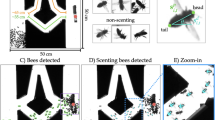Abstract
Honey bees are social insects that forage for flower nectar cooperatively. When an individual forager discovers a flower patch rich in nectar, it returns to the hive and performs a “waggle dance” in the vicinity of other bees that consists of movements communicating the direction and distance to the nectar source. The dance recruits “witnessing” bees to fly to the location of the nectar to retrieve it, thus cooperatively exploiting the environment. Replicating such complex animal behavior is a step forward on the path to artificial intelligence. This project simulates the bee foraging behavior in a cellular automaton using the Morphognosis machine learning model. The model features hierarchical spatial and temporal contexts that output motor responses from sensory inputs. Given a set of bee foraging and dancing exemplars, and exposing only the external input-output of these behaviors to the Morphognosis learning algorithm, a hive of artificial bees can be generated that forage as their biological counterparts do. A comparison of Morphognosis foraging performance with that of an artificial recurrent neural network is also presented.
Access this chapter
Tax calculation will be finalised at checkout
Purchases are for personal use only
Similar content being viewed by others
References
Betti, M., LeClair, J., Wahl, L.M., Zamir, M.: Bee++: an object-oriented, agent-based simulator for honey bee colonies. Insects, 8(1), 31 (2017) https://doi.org/10.3390/insects8010031
Chittka, L., Wilson, C.: Bee-brained. Are insects philosophical zombies with no inner life? Close attention to their behaviours and moods suggests otherwise. Aeon (2018). https://aeon.co/essays/inside-the-mind-of-a-bee-is-a-hive-of-sensory-activity
Cueva, C.J., Wei, X.: Emergence of grid-like representations by training recurrent neural networks to perform spatial localization. ICLR 2018 (2018). arXiv:1803.07770
Dornhaus, A., Klügl, F., Oechslein, C., Puppe, F., Chittka, L.: Benefits of recruitment in honey bees: effects of ecology and colony size in an individual-based model. Behav. Ecol. (2006). https://doi.org/10.1093/beheco/arj036
Elman, J.L.: Finding structure in time. Cogn. Sci. 14(2), 179–211 (1990)
Fox, A.: Bees ‘get’ addition and subtraction, new study suggests. Sci. Mag. (2019). https://www.sciencemag.org/news/2019/02/bees-get-addition-and-subtraction-new-study-suggests
Hochreiter, S., Schmidhuber, J.: Long short-term memory. Neural Comput. 9(8), 1735–1780 (1997)
Karaboga, D., Akay, B.: A survey: algorithms simulating bee swarm intelligence. Artif. Intell. Rev. 31, 61-85 (2009)
Lieff, J.: Time Cells Organize Memory (2015). http://jonlieffmd.com/blog/time-cells-organize-memory
Nosowitz, D.: I Asked Leading Entomologists: What’s The Smartest Bug In The World? Atlas Obscura (2016).. https://getpocket.com/explore/item/i-asked-leading-entomologists-what-s-the-smartest-bug-in-the-world?utm_source=pocket-newtab
Portegys, T.: Learning C. elegans locomotion and foraging with a hierarchical space-time cellular automaton. Neuroinformatics 2018 Montreal. F1000Research, 7, 1192 (2018). https://doi.org/10.7490/f1000research.1115884.1)
Portegys, T.: Generating an artificial nest building pufferfish in a cellular automaton through behavior decomposition. Int. J. Artif. Intell. Mach. Learn. (IJAIML) 9(1), 1–12 (2019). https://doi.org/10.4018/IJAIML.2019010101
Schürch, R., Zwirner, K., Yambrick, B., Pirault, T., Wilson, J.M., Couvillon, M.J.: Dismantling babel: creation of a universal calibration for honey bee waggle dance decoding. Anim. Behav. (2019). https://doi.org/10.1016/j.anbehav.2019.01.016
Von Frisch, K.: The Dance Language and Orientation of Bees, p. 9780674418776. Harvard University Press, ISBN (1967)
Vorhees, C.V., Williams, M.T.: Assessing spatial learning and memory in rodents. ILAR J. 55(2), 310–332 (2014). https://doi.org/10.1093/ilar/ilu013
Author information
Authors and Affiliations
Corresponding author
Editor information
Editors and Affiliations
Rights and permissions
Copyright information
© 2023 The Author(s), under exclusive license to Springer Nature Switzerland AG
About this paper
Cite this paper
Portegys, T.E. (2023). Morphognostic Honey Bees Communicating Nectar Location Through Dance Movements. In: Abraham, A., Hanne, T., Gandhi, N., Manghirmalani Mishra, P., Bajaj, A., Siarry, P. (eds) Proceedings of the 14th International Conference on Soft Computing and Pattern Recognition (SoCPaR 2022). SoCPaR 2022. Lecture Notes in Networks and Systems, vol 648. Springer, Cham. https://doi.org/10.1007/978-3-031-27524-1_72
Download citation
DOI: https://doi.org/10.1007/978-3-031-27524-1_72
Published:
Publisher Name: Springer, Cham
Print ISBN: 978-3-031-27523-4
Online ISBN: 978-3-031-27524-1
eBook Packages: Intelligent Technologies and RoboticsIntelligent Technologies and Robotics (R0)




